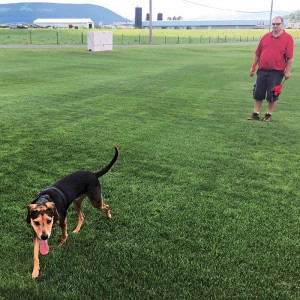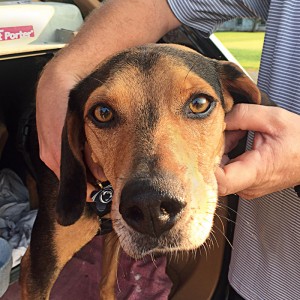Scent-detecting canines help sniff out annual bluegrass weevil

An adult beagle detects hidden samples of ABW in a controlled field trial at the Penn State turfgrass research center.
The annual bluegrass weevil (ABW) is the most destructive insect pest of golf course turf in the mid-Atlantic and northeastern United States and eastern Canadian provinces. The insect is believed to be native to North America, yet damaging populations continue to spread outward annually from the New York metropolitan area, the site of its initial detection in the late 1950s.
Detecting ABW populations in unreported areas is essential to preventing unexpected turf loss, limiting its spread into new regions and in our understanding of the how this pest is evolving.
However, using traditional sampling techniques (e.g. soil sampling, soap flushing) are not a practical approach in early detection, given the small size of the insect, its cryptic nature and the spatial scale of a golf course.
The Turfgrass Entomology Lab at Pennsylvania State University has been exploring the use of scent-detecting canines as a means to locate weevils. Canines have long been used in the location of specific odors, though only recently have efforts focused on insect pests. Dogs have the advantage of relying on olfaction rather than vision, so they are capable of searching large areas efficiently and have a greater probability for detecting low-density populations.
 ABW adults were provided regularly throughout the season to canine handlers in order to train a four-year-old male beagle. Our first trial assessed the dog’s ability to discriminate between ABW and non-target odors (Japanese beetle, Poa annua blanks) in fairway-height turf. The dog was led by its handler through different areas containing conical tubes housing the adult weevils. We assessed the dog for accuracy in alerting to ABW, as well as the total time spent searching. Results indicated that the dog was capable of discriminating between ABW and non-target odors (positive alerts exceeded 75 percent). After another month of imprinting, the dog assessed in a second controlled field trial in both rough- and fairway-height turf. The dog demonstrated improved success at locating the hidden weevils (88 percent) and was not affected by the height of the turf canopy.
ABW adults were provided regularly throughout the season to canine handlers in order to train a four-year-old male beagle. Our first trial assessed the dog’s ability to discriminate between ABW and non-target odors (Japanese beetle, Poa annua blanks) in fairway-height turf. The dog was led by its handler through different areas containing conical tubes housing the adult weevils. We assessed the dog for accuracy in alerting to ABW, as well as the total time spent searching. Results indicated that the dog was capable of discriminating between ABW and non-target odors (positive alerts exceeded 75 percent). After another month of imprinting, the dog assessed in a second controlled field trial in both rough- and fairway-height turf. The dog demonstrated improved success at locating the hidden weevils (88 percent) and was not affected by the height of the turf canopy.
Future studies will examine the ability of canines to detect different ABW life stages as well as the ability to locate adult populations in overwintering sites. It’s our hope that the research will assist in our understanding population locations within a golf course, as well as within the greater region.
Photos by: Ben McGraw, Ph.D.








